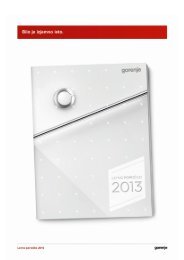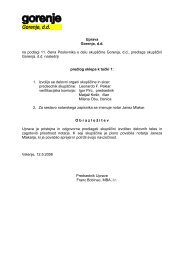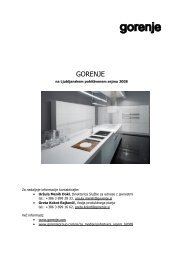Annual Report Gorenje Group 2009
Annual Report Gorenje Group 2009
Annual Report Gorenje Group 2009
Create successful ePaper yourself
Turn your PDF publications into a flip-book with our unique Google optimized e-Paper software.
current economic and credit conditions are such that the actual losses are likely to be greater or less<br />
than suggested by historical trends.<br />
An impairment loss in respect of a financial asset measured at amortised cost is calculated as the<br />
difference between its carrying amount and the present value of the estimated future cash flows<br />
discounted at the asset's original effective interest rate. Losses are recognised in profit or loss and<br />
reflected in an allowance account against receivables. Interest on the impaired asset continues to be<br />
recognised through the unwinding of the discount. When a subsequent event causes the amount of<br />
impairment loss to decrease, the decrease in impairment loss is reversed through profit or loss.<br />
Impairment losses on available-for-sale investment securities are recognised by transferring the<br />
cumulative loss that has been recognised in other comprehensive income, and presented in the fair<br />
value reserve in equity, to profit or loss. The cumulative loss that is removed from other comprehensive<br />
income and recognised in profit or loss is the difference between the acquisition cost, net of any<br />
principal repayment and amortisation, and the current fair value, less any impairment loss previously<br />
recognised in profit or loss. Changes in impairment provisions attributable to time value are reflected as<br />
a component of interest income.<br />
Impairment losses on receivables are recognised in accordance with the item by item principle where<br />
bankruptcy procedures or compulsory compositions have been initiated, or on the basis of disputability<br />
or doubtfulness of receivables.<br />
(ii) Non-financial assets<br />
The carrying amounts of the <strong>Group</strong>'s non-financial assets, other than investment property, inventories<br />
and deferred tax assets, are reviewed at each reporting date to determine whether there is any<br />
indication of impairment. If any such indication exists, then the asset's recoverable amount is<br />
estimated. For goodwill, and intangible assets that have indefinite useful lives or that are not yet<br />
available for use, the recoverable amount is estimated each year at the reporting date.<br />
The recoverable amount of an asset or cash-generating unit is the greater of its value in use and its fair<br />
value less costs to sell. In assessing value in use, the estimated future cash flows are discounted to<br />
their present value using a pre-tax discount rate that reflects current market assessments of the time<br />
value of money and the risks specific to the asset. For the purpose of impairment testing, assets that<br />
cannot be tested individually are grouped together into the smallest group of assets that generates<br />
cash inflows from continuing use that are largely independent of the cash inflows of other assets or<br />
groups of assets (the "cash-generating unit, or CGU"). For the purposes of goodwill impairment testing,<br />
goodwill acquired in a business combination is allocated to groups of CGUs that are expected to<br />
benefit from the synergies of the combination.<br />
An impairment loss is recognised if the carrying amount of an asset or its CGU exceeds its estimated<br />
recoverable amount. Impairment losses are recognised in profit or loss. Impairment losses recognised<br />
in respect of CGUs are allocated first to reduce the carrying amount of any goodwill allocated to the<br />
units, and then to reduce the carrying amounts of the other assets in the unit (group of units) on a pro<br />
rata basis.<br />
An impairment loss in respect of goodwill is not reversed. In respect of other assets, impairment losses<br />
recognised in prior periods are assessed at each reporting date for any indications that the loss has<br />
decreased or no longer exists. An impairment loss is reversed if there has been a change in the<br />
estimates used to determine the recoverable amount. An impairment loss is reversed only to the extent<br />
that the asset's carrying amount does not exceed the carrying amount that would have been<br />
determined, net of depreciation or amortisation, if no impairment loss had been recognised.<br />
106<br />
<strong>Annual</strong> <strong>Report</strong> <strong>Gorenje</strong> <strong>Group</strong> <strong>2009</strong>

















